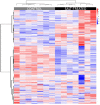Single cell-type comparative metabolomics of epidermal bladder cells from the halophyte Mesembryanthemum crystallinum
- PMID: 26113856
- PMCID: PMC4462104
- DOI: 10.3389/fpls.2015.00435
Single cell-type comparative metabolomics of epidermal bladder cells from the halophyte Mesembryanthemum crystallinum
Abstract
One of the remarkable adaptive features of the halophyte Mesembryanthemum crystallinum are the specialized modified trichomes called epidermal bladder cells (EBC) which cover the leaves, stems, and peduncle of the plant. They are present from an early developmental stage but upon salt stress rapidly expand due to the accumulation of water and sodium. This particular plant feature makes it an attractive system for single cell type studies, with recent proteomics and transcriptomics studies of the EBC establishing that these cells are metabolically active and have roles other than sodium sequestration. To continue our investigation into the function of these unusual cells we carried out a comprehensive global analysis of the metabolites present in the EBC extract by gas chromatography Time-of-Flight mass spectrometry (GC-TOF) and identified 194 known and 722 total molecular features. Statistical analysis of the metabolic changes between control and salt-treated samples identified 352 significantly differing metabolites (268 after correction for FDR). Principal components analysis provided an unbiased evaluation of the data variance structure. Biochemical pathway enrichment analysis suggested significant perturbations in 13 biochemical pathways as defined in KEGG. More than 50% of the metabolites that show significant changes in the EBC, can be classified as compatible solutes and include sugars, sugar alcohols, protein and non-protein amino acids, and organic acids, highlighting the need to maintain osmotic homeostasis to balance the accumulation of Na(+) and Cl(-) ions. Overall, the comparison of metabolic changes in salt treated relative to control samples suggests large alterations in M. crystallinum epidermal bladder cells.
Keywords: Crassulacean acid metabolism; Mesembryanthemum crystallinum; epidermal bladder cells; halophyte; metabolomics; salinity; salt-tolerance; trichomes.
Figures




Similar articles
-
Single-cell-type quantitative proteomic and ionomic analysis of epidermal bladder cells from the halophyte model plant Mesembryanthemum crystallinum to identify salt-responsive proteins.BMC Plant Biol. 2016 May 10;16(1):110. doi: 10.1186/s12870-016-0797-1. BMC Plant Biol. 2016. PMID: 27160145 Free PMC article.
-
Protein profiling of epidermal bladder cells from the halophyte Mesembryanthemum crystallinum.Proteomics. 2012 Sep;12(18):2862-5. doi: 10.1002/pmic.201200152. Epub 2012 Aug 22. Proteomics. 2012. PMID: 22848050
-
Salt tolerance, salt accumulation, and ionic homeostasis in an epidermal bladder-cell-less mutant of the common ice plant Mesembryanthemum crystallinum.J Exp Bot. 2007;58(8):1957-67. doi: 10.1093/jxb/erm057. Epub 2007 Apr 23. J Exp Bot. 2007. PMID: 17452753
-
Cell type-specific responses to salinity - the epidermal bladder cell transcriptome of Mesembryanthemum crystallinum.New Phytol. 2015 Aug;207(3):627-44. doi: 10.1111/nph.13414. Epub 2015 May 5. New Phytol. 2015. PMID: 25944243
-
Single cell-type analysis of cellular lipid remodelling in response to salinity in the epidermal bladder cells of the model halophyte Mesembryanthemum crystallinum.Plant Cell Environ. 2018 Oct;41(10):2390-2403. doi: 10.1111/pce.13352. Epub 2018 Jul 3. Plant Cell Environ. 2018. PMID: 29813189
Cited by
-
Mechanisms of Salt Tolerance in Halophytes: Current Understanding and Recent Advances.Open Life Sci. 2018 May 18;13:149-154. doi: 10.1515/biol-2018-0020. eCollection 2018 Jan. Open Life Sci. 2018. PMID: 33817080 Free PMC article.
-
Single-cell-type quantitative proteomic and ionomic analysis of epidermal bladder cells from the halophyte model plant Mesembryanthemum crystallinum to identify salt-responsive proteins.BMC Plant Biol. 2016 May 10;16(1):110. doi: 10.1186/s12870-016-0797-1. BMC Plant Biol. 2016. PMID: 27160145 Free PMC article.
-
Beneficial Effects of Salt on Halophyte Growth: Morphology, Cells, and Genes.Open Life Sci. 2019 Jun 24;14:191-200. doi: 10.1515/biol-2019-0021. eCollection 2019 Jan. Open Life Sci. 2019. PMID: 33817151 Free PMC article.
-
Who Rules the Cell? An Epi-Tale of Histone, DNA, RNA, and the Metabolic Deep State.Front Plant Sci. 2020 Mar 5;11:181. doi: 10.3389/fpls.2020.00181. eCollection 2020. Front Plant Sci. 2020. PMID: 32194593 Free PMC article. Review.
-
Progress in Studying Salt Secretion from the Salt Glands in Recretohalophytes: How Do Plants Secrete Salt?Front Plant Sci. 2016 Jun 30;7:977. doi: 10.3389/fpls.2016.00977. eCollection 2016. Front Plant Sci. 2016. PMID: 27446195 Free PMC article. Review.
References
-
- Adams P., Thomas J. C., Vernon D. M., Bohnert H. J., Jensen R. G. (1992). Distinct cellular and organismic responses to salt stress. Plant Cell Physiol. 33, 1215–1223.
LinkOut - more resources
Full Text Sources
Other Literature Sources
Miscellaneous

